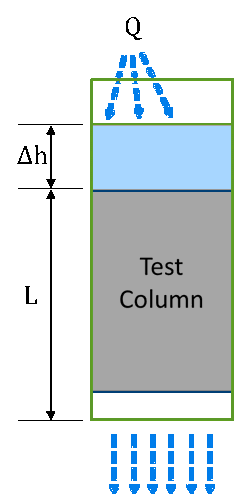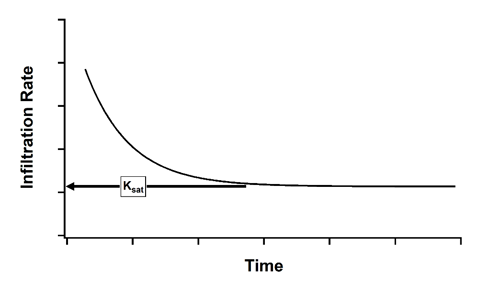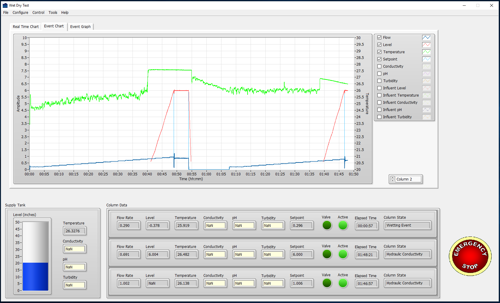
Put Your Bioretention Media Testing on Autopilot
At the heart of every bioretention system is the media that captures and immobilizes pollutants that are then decomposed, volatilized and incorporated into the biomass of the system’s micro/macro fauna and flora. Bioretention media cannot be the heart of the system removing the intended pollutant load when flow rate is compromised due to premature bypass from unqualified media. Bioretention media does not always meet hydraulic design rates due to excessive organic material or silt and clay, fine aggregate size, contaminated source material or lack of homogeneity within the blend. Bioretention media naturally contains composition variability since components are sourced from natural products and media production is a batch process. Following quality assurance and control (QA/QC) measures ensures engineered media composition satisfies specific hydraulic targets, which is crucial to consistent performance success.
Bioretention systems, such as swales or basins, often use volume-based sizing and pond or store the water quality design volume above the soil or media surface for volume reduction. To increase water quality design storm storage, both storage volume above the media as well as the media pore volume are sometimes used to determine stored volume, putting more emphases on qualified media. Most importantly, bioretention media needs to perform as expected to prevent risk of flooding upstream systems and/or bypassing untreated volume. Hence, hydraulic conductivity quality control testing of media under design conditions ensures the bioretention system performs as intended.
Bench-scale laboratory testing utilizing columns or permeameters is common practice for hydraulic conductivity evaluation such as ASTM D2434-68 (Permeability of Granular Soils) and ASTM D7664 (Standard Test Methods for Measurement of Hydraulic Conductivity of Unsaturated Soils). Infiltration rate can differ significantly from hydraulic conductivity as it is impacted by head development on the media surface as well as media depth, and Darcy’s Law depicts this relationship. Hydraulic conductivity is a function of water content in soils, therefore saturated hydraulic conductivity (Ksat) is a more conservative approach over unsaturated hydraulic conductivity since Ksat represents typical media conditions during a storm event. Ksat is a required parameter by Washington State Department of Ecology’s Technology Assessment Protocol – Ecology (TAPE) Program for evaluation of stormwater treatment technologies.
Hydraulic conductivity, K, is a parameter in the Darcy’s Law equation where, 𝑄 is the volume flowrate, 𝐴 is the cross-sectional area, 𝐿 is the length of the flow path, and Δh = (ℎ1 − ℎ2) is the driving head (Figure 1).


Figure 1: Test column illustration
Laboratory determination of hydraulic conductivity requires multiple cycles of testing as both changes in compaction and saturation will change the observed hydraulic conductivity. Each hydraulic test requires precision monitoring of flow rate and water level measurements.
The entire media profile depth should be tested under saturated conditions to ensure the flow rate is at capacity throughout the media bed. Testing with underdrain ensures the underdrain bridges with the media and functions as designed. Initial permeability of dry bioretention media can be very rapid, and permeability will decrease as the media wets and organic material swells. Assuming constant head conditions, the infiltration rate will equilibrate after some time, approaching the internal permeability of the underlying media defined as Ksat. The relationship between infiltration rate and time is depicted in Figure 2.

Figure 2: The effect of time on infiltrate rate as media reaches saturation under constant head conditions
Over the course of a year, Contech R&D conducts hundreds of hydraulic laboratory tests as we ensure every bioretention media batch meets design specifications. Hydraulic conductivity testing is useful not only during initial verification of design specification, but also as a continued quality control measure as source materials or suppliers can change over time.

Figure 3: User interface for automated hydraulic conductivity test system
An innovative approach to hydraulic evaluation by Contech R&D has allowed the time consuming, manual process to be improved via automation. The infiltration rate evaluation determination is now an automated process allowing for a great deal of user flexibility. Tests can be started independently at a scheduled time, with test parameters entered by the user. For each column, the software independently controls the pumps, logs all sensor data, displays data in real time (Figure 3), calculates values of interest, and saves data in a convenient report format. Automation of the hydraulic testing apparatus has increased experimental throughput and reduced the opportunity for human error. The capabilities of the automated system support hydraulic QA/QC evaluation for media production.
